MgMT20144 Organizational Management: Annotated Bibliography Essay
VerifiedAdded on 2023/06/09
|8
|2239
|404
Annotated Bibliography
AI Summary
This annotated bibliography analyzes five management and business studies journals to understand factors influencing managerial business decisions. It discusses organizational governance, market environmental forces, business risks, organizational practices, and diversity, and their impact on firm performance. The analysis identifies new business practice theories influencing companies' pragmatic decision-making. The journals cover business model innovation, dynamic capabilities, enterprise risk management in SMEs, entrepreneurial orientation and firm strategy, and racial diversity's role in firm performance. The conclusion emphasizes the importance of considering organizational structure, external forces, business practices, risk factors, and diverse human resources for effective management and improved organizational performance.
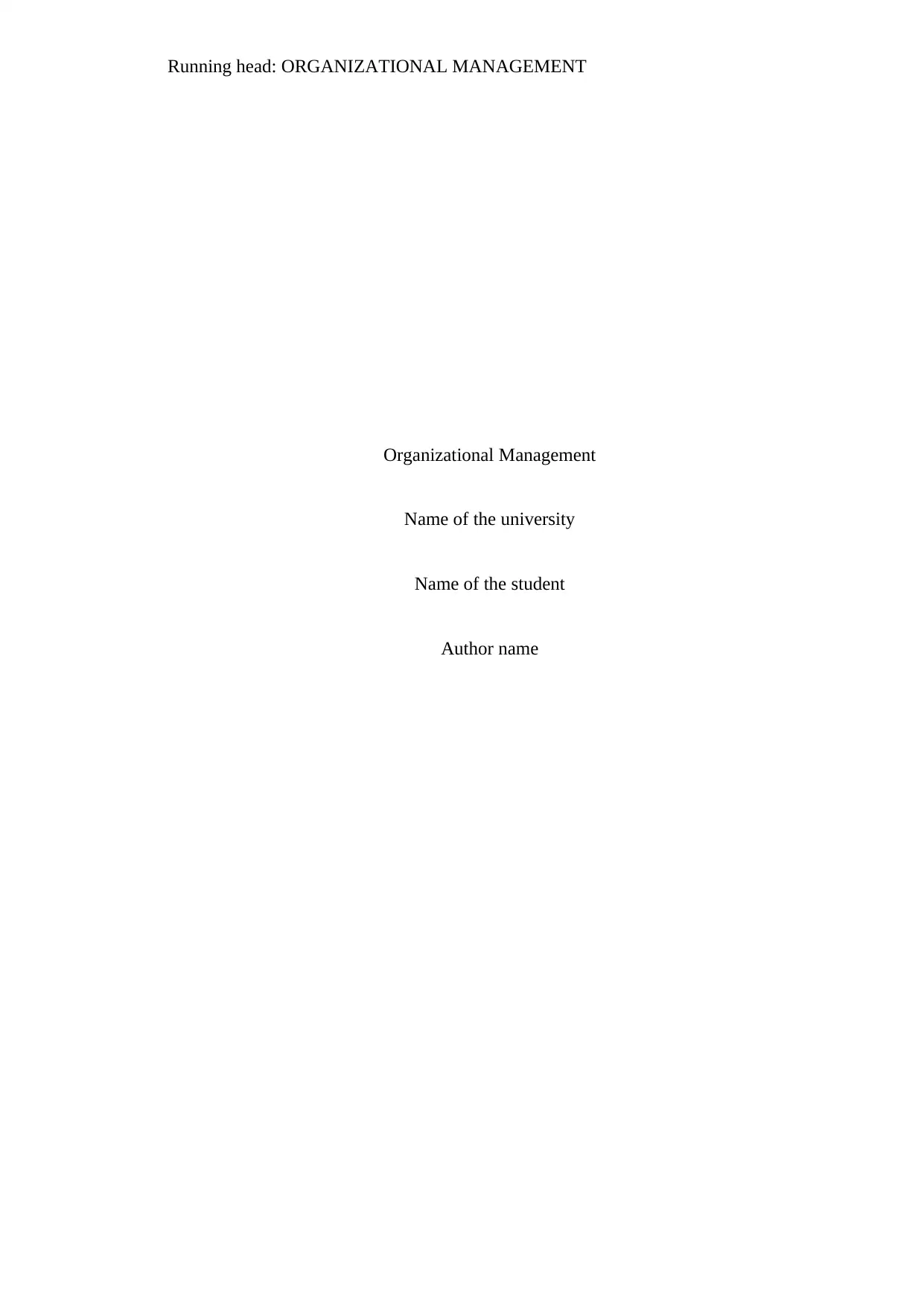
Running head: ORGANIZATIONAL MANAGEMENT
Organizational Management
Name of the university
Name of the student
Author name
Organizational Management
Name of the university
Name of the student
Author name
Paraphrase This Document
Need a fresh take? Get an instant paraphrase of this document with our AI Paraphraser
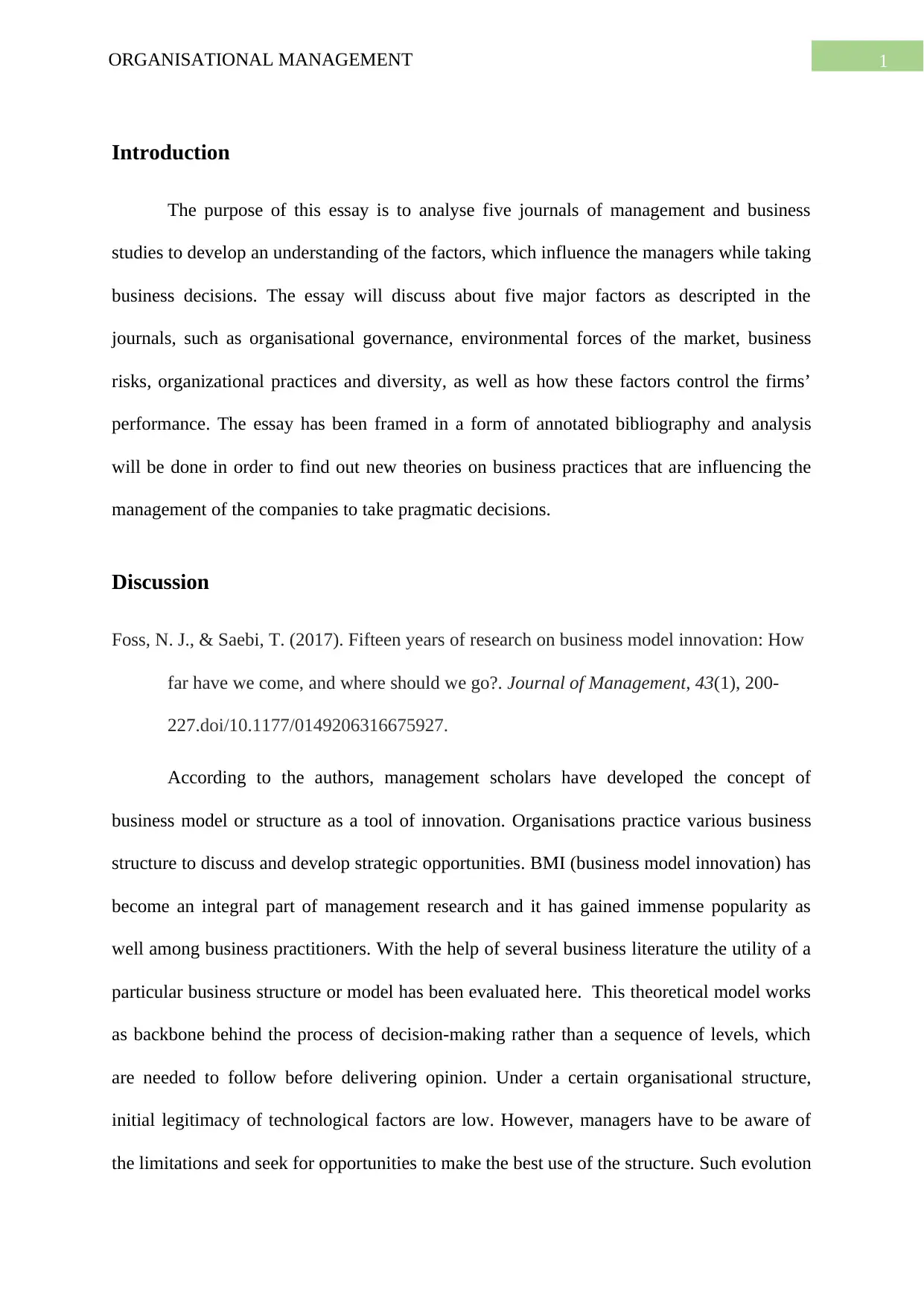
1ORGANISATIONAL MANAGEMENT
Introduction
The purpose of this essay is to analyse five journals of management and business
studies to develop an understanding of the factors, which influence the managers while taking
business decisions. The essay will discuss about five major factors as descripted in the
journals, such as organisational governance, environmental forces of the market, business
risks, organizational practices and diversity, as well as how these factors control the firms’
performance. The essay has been framed in a form of annotated bibliography and analysis
will be done in order to find out new theories on business practices that are influencing the
management of the companies to take pragmatic decisions.
Discussion
Foss, N. J., & Saebi, T. (2017). Fifteen years of research on business model innovation: How
far have we come, and where should we go?. Journal of Management, 43(1), 200-
227.doi/10.1177/0149206316675927.
According to the authors, management scholars have developed the concept of
business model or structure as a tool of innovation. Organisations practice various business
structure to discuss and develop strategic opportunities. BMI (business model innovation) has
become an integral part of management research and it has gained immense popularity as
well among business practitioners. With the help of several business literature the utility of a
particular business structure or model has been evaluated here. This theoretical model works
as backbone behind the process of decision-making rather than a sequence of levels, which
are needed to follow before delivering opinion. Under a certain organisational structure,
initial legitimacy of technological factors are low. However, managers have to be aware of
the limitations and seek for opportunities to make the best use of the structure. Such evolution
Introduction
The purpose of this essay is to analyse five journals of management and business
studies to develop an understanding of the factors, which influence the managers while taking
business decisions. The essay will discuss about five major factors as descripted in the
journals, such as organisational governance, environmental forces of the market, business
risks, organizational practices and diversity, as well as how these factors control the firms’
performance. The essay has been framed in a form of annotated bibliography and analysis
will be done in order to find out new theories on business practices that are influencing the
management of the companies to take pragmatic decisions.
Discussion
Foss, N. J., & Saebi, T. (2017). Fifteen years of research on business model innovation: How
far have we come, and where should we go?. Journal of Management, 43(1), 200-
227.doi/10.1177/0149206316675927.
According to the authors, management scholars have developed the concept of
business model or structure as a tool of innovation. Organisations practice various business
structure to discuss and develop strategic opportunities. BMI (business model innovation) has
become an integral part of management research and it has gained immense popularity as
well among business practitioners. With the help of several business literature the utility of a
particular business structure or model has been evaluated here. This theoretical model works
as backbone behind the process of decision-making rather than a sequence of levels, which
are needed to follow before delivering opinion. Under a certain organisational structure,
initial legitimacy of technological factors are low. However, managers have to be aware of
the limitations and seek for opportunities to make the best use of the structure. Such evolution
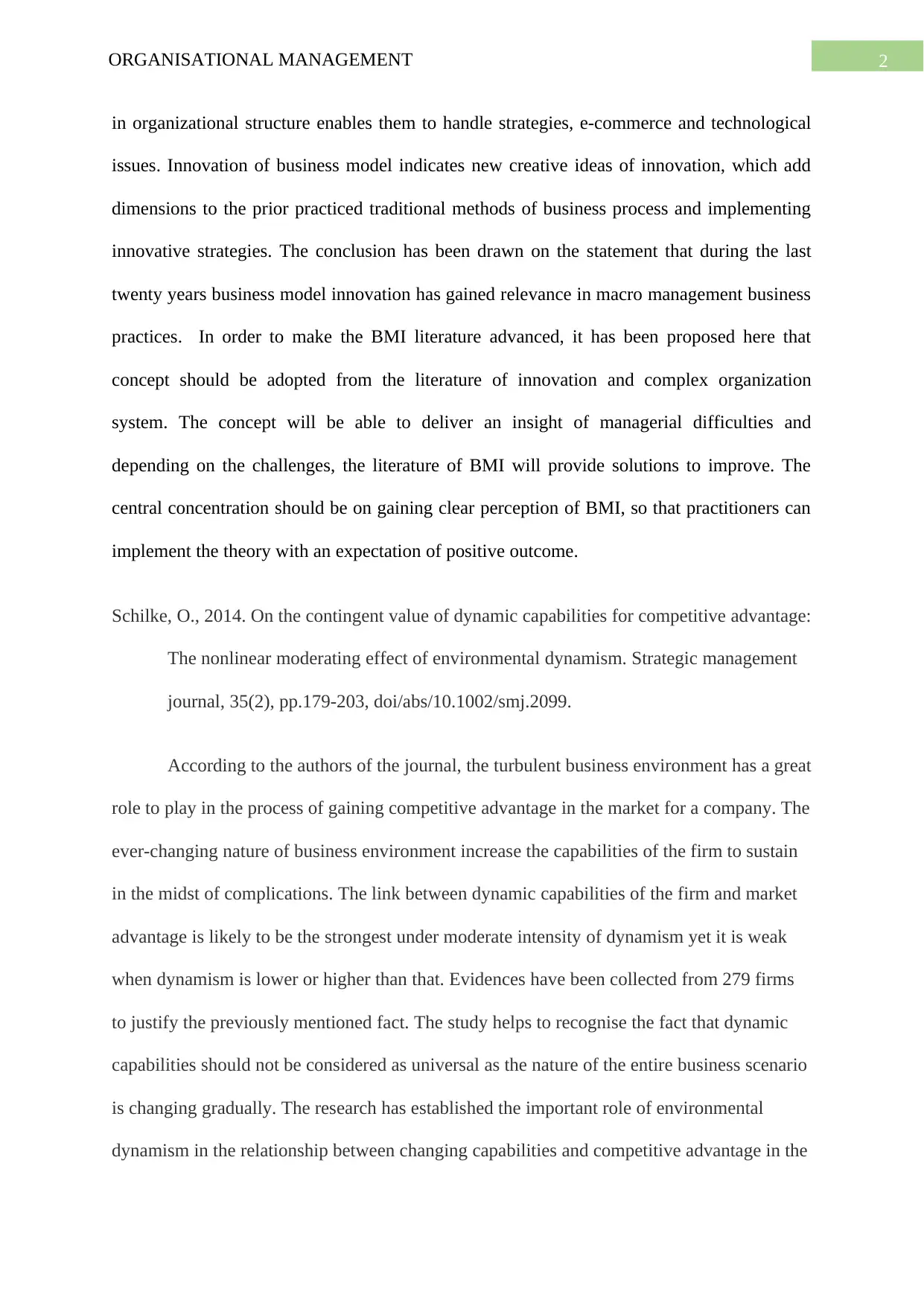
2ORGANISATIONAL MANAGEMENT
in organizational structure enables them to handle strategies, e-commerce and technological
issues. Innovation of business model indicates new creative ideas of innovation, which add
dimensions to the prior practiced traditional methods of business process and implementing
innovative strategies. The conclusion has been drawn on the statement that during the last
twenty years business model innovation has gained relevance in macro management business
practices. In order to make the BMI literature advanced, it has been proposed here that
concept should be adopted from the literature of innovation and complex organization
system. The concept will be able to deliver an insight of managerial difficulties and
depending on the challenges, the literature of BMI will provide solutions to improve. The
central concentration should be on gaining clear perception of BMI, so that practitioners can
implement the theory with an expectation of positive outcome.
Schilke, O., 2014. On the contingent value of dynamic capabilities for competitive advantage:
The nonlinear moderating effect of environmental dynamism. Strategic management
journal, 35(2), pp.179-203, doi/abs/10.1002/smj.2099.
According to the authors of the journal, the turbulent business environment has a great
role to play in the process of gaining competitive advantage in the market for a company. The
ever-changing nature of business environment increase the capabilities of the firm to sustain
in the midst of complications. The link between dynamic capabilities of the firm and market
advantage is likely to be the strongest under moderate intensity of dynamism yet it is weak
when dynamism is lower or higher than that. Evidences have been collected from 279 firms
to justify the previously mentioned fact. The study helps to recognise the fact that dynamic
capabilities should not be considered as universal as the nature of the entire business scenario
is changing gradually. The research has established the important role of environmental
dynamism in the relationship between changing capabilities and competitive advantage in the
in organizational structure enables them to handle strategies, e-commerce and technological
issues. Innovation of business model indicates new creative ideas of innovation, which add
dimensions to the prior practiced traditional methods of business process and implementing
innovative strategies. The conclusion has been drawn on the statement that during the last
twenty years business model innovation has gained relevance in macro management business
practices. In order to make the BMI literature advanced, it has been proposed here that
concept should be adopted from the literature of innovation and complex organization
system. The concept will be able to deliver an insight of managerial difficulties and
depending on the challenges, the literature of BMI will provide solutions to improve. The
central concentration should be on gaining clear perception of BMI, so that practitioners can
implement the theory with an expectation of positive outcome.
Schilke, O., 2014. On the contingent value of dynamic capabilities for competitive advantage:
The nonlinear moderating effect of environmental dynamism. Strategic management
journal, 35(2), pp.179-203, doi/abs/10.1002/smj.2099.
According to the authors of the journal, the turbulent business environment has a great
role to play in the process of gaining competitive advantage in the market for a company. The
ever-changing nature of business environment increase the capabilities of the firm to sustain
in the midst of complications. The link between dynamic capabilities of the firm and market
advantage is likely to be the strongest under moderate intensity of dynamism yet it is weak
when dynamism is lower or higher than that. Evidences have been collected from 279 firms
to justify the previously mentioned fact. The study helps to recognise the fact that dynamic
capabilities should not be considered as universal as the nature of the entire business scenario
is changing gradually. The research has established the important role of environmental
dynamism in the relationship between changing capabilities and competitive advantage in the
⊘ This is a preview!⊘
Do you want full access?
Subscribe today to unlock all pages.

Trusted by 1+ million students worldwide
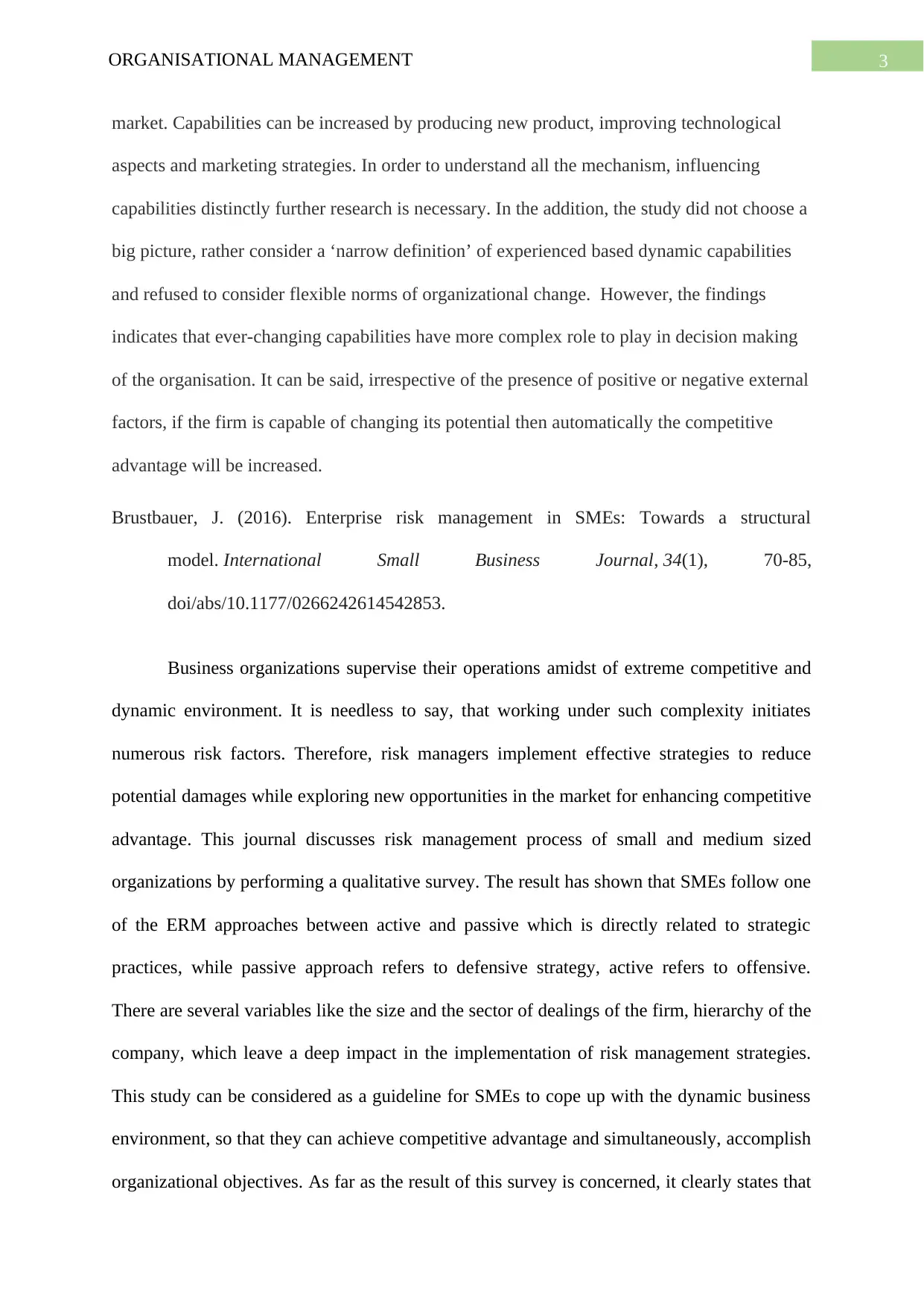
3ORGANISATIONAL MANAGEMENT
market. Capabilities can be increased by producing new product, improving technological
aspects and marketing strategies. In order to understand all the mechanism, influencing
capabilities distinctly further research is necessary. In the addition, the study did not choose a
big picture, rather consider a ‘narrow definition’ of experienced based dynamic capabilities
and refused to consider flexible norms of organizational change. However, the findings
indicates that ever-changing capabilities have more complex role to play in decision making
of the organisation. It can be said, irrespective of the presence of positive or negative external
factors, if the firm is capable of changing its potential then automatically the competitive
advantage will be increased.
Brustbauer, J. (2016). Enterprise risk management in SMEs: Towards a structural
model. International Small Business Journal, 34(1), 70-85,
doi/abs/10.1177/0266242614542853.
Business organizations supervise their operations amidst of extreme competitive and
dynamic environment. It is needless to say, that working under such complexity initiates
numerous risk factors. Therefore, risk managers implement effective strategies to reduce
potential damages while exploring new opportunities in the market for enhancing competitive
advantage. This journal discusses risk management process of small and medium sized
organizations by performing a qualitative survey. The result has shown that SMEs follow one
of the ERM approaches between active and passive which is directly related to strategic
practices, while passive approach refers to defensive strategy, active refers to offensive.
There are several variables like the size and the sector of dealings of the firm, hierarchy of the
company, which leave a deep impact in the implementation of risk management strategies.
This study can be considered as a guideline for SMEs to cope up with the dynamic business
environment, so that they can achieve competitive advantage and simultaneously, accomplish
organizational objectives. As far as the result of this survey is concerned, it clearly states that
market. Capabilities can be increased by producing new product, improving technological
aspects and marketing strategies. In order to understand all the mechanism, influencing
capabilities distinctly further research is necessary. In the addition, the study did not choose a
big picture, rather consider a ‘narrow definition’ of experienced based dynamic capabilities
and refused to consider flexible norms of organizational change. However, the findings
indicates that ever-changing capabilities have more complex role to play in decision making
of the organisation. It can be said, irrespective of the presence of positive or negative external
factors, if the firm is capable of changing its potential then automatically the competitive
advantage will be increased.
Brustbauer, J. (2016). Enterprise risk management in SMEs: Towards a structural
model. International Small Business Journal, 34(1), 70-85,
doi/abs/10.1177/0266242614542853.
Business organizations supervise their operations amidst of extreme competitive and
dynamic environment. It is needless to say, that working under such complexity initiates
numerous risk factors. Therefore, risk managers implement effective strategies to reduce
potential damages while exploring new opportunities in the market for enhancing competitive
advantage. This journal discusses risk management process of small and medium sized
organizations by performing a qualitative survey. The result has shown that SMEs follow one
of the ERM approaches between active and passive which is directly related to strategic
practices, while passive approach refers to defensive strategy, active refers to offensive.
There are several variables like the size and the sector of dealings of the firm, hierarchy of the
company, which leave a deep impact in the implementation of risk management strategies.
This study can be considered as a guideline for SMEs to cope up with the dynamic business
environment, so that they can achieve competitive advantage and simultaneously, accomplish
organizational objectives. As far as the result of this survey is concerned, it clearly states that
Paraphrase This Document
Need a fresh take? Get an instant paraphrase of this document with our AI Paraphraser
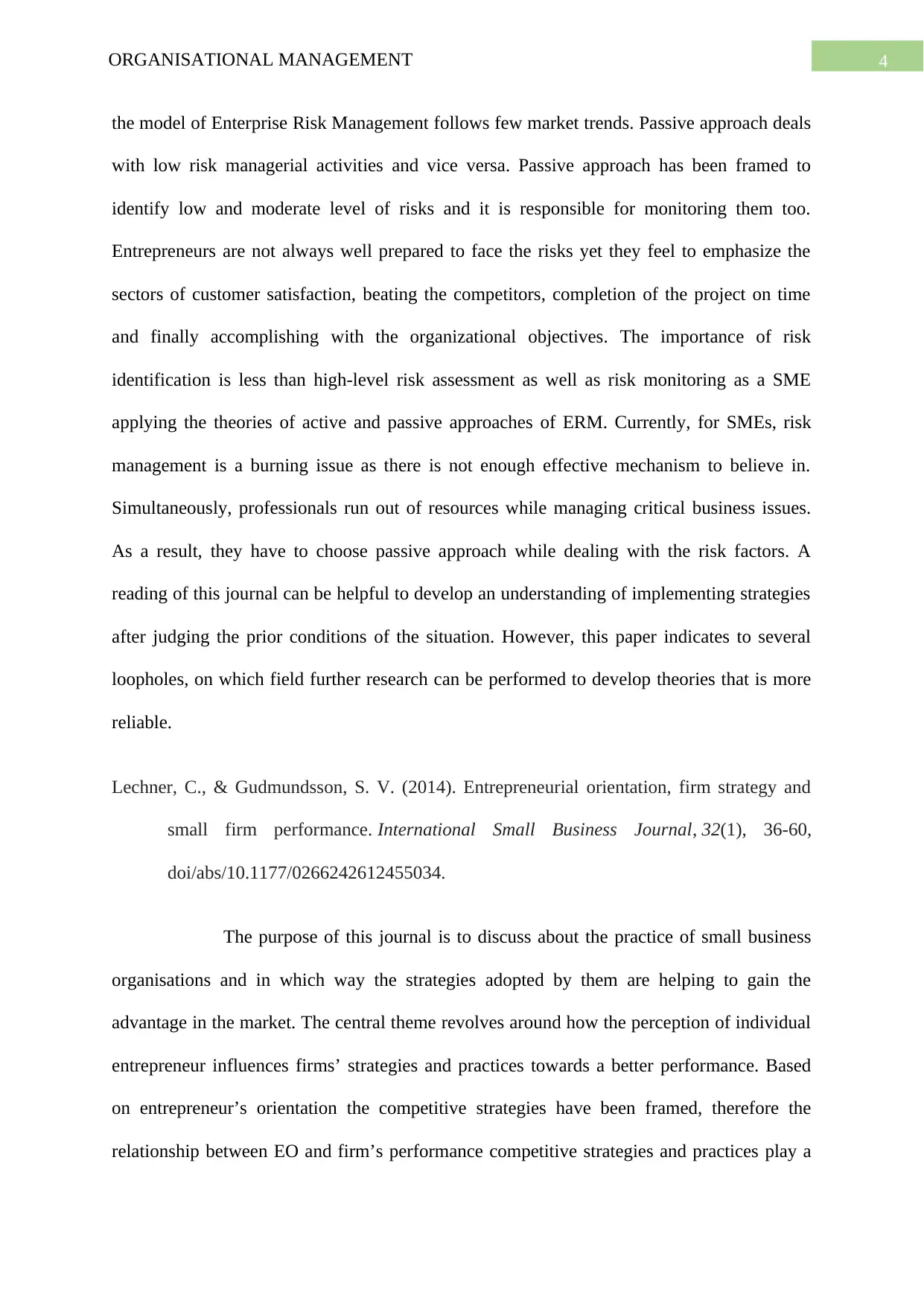
4ORGANISATIONAL MANAGEMENT
the model of Enterprise Risk Management follows few market trends. Passive approach deals
with low risk managerial activities and vice versa. Passive approach has been framed to
identify low and moderate level of risks and it is responsible for monitoring them too.
Entrepreneurs are not always well prepared to face the risks yet they feel to emphasize the
sectors of customer satisfaction, beating the competitors, completion of the project on time
and finally accomplishing with the organizational objectives. The importance of risk
identification is less than high-level risk assessment as well as risk monitoring as a SME
applying the theories of active and passive approaches of ERM. Currently, for SMEs, risk
management is a burning issue as there is not enough effective mechanism to believe in.
Simultaneously, professionals run out of resources while managing critical business issues.
As a result, they have to choose passive approach while dealing with the risk factors. A
reading of this journal can be helpful to develop an understanding of implementing strategies
after judging the prior conditions of the situation. However, this paper indicates to several
loopholes, on which field further research can be performed to develop theories that is more
reliable.
Lechner, C., & Gudmundsson, S. V. (2014). Entrepreneurial orientation, firm strategy and
small firm performance. International Small Business Journal, 32(1), 36-60,
doi/abs/10.1177/0266242612455034.
The purpose of this journal is to discuss about the practice of small business
organisations and in which way the strategies adopted by them are helping to gain the
advantage in the market. The central theme revolves around how the perception of individual
entrepreneur influences firms’ strategies and practices towards a better performance. Based
on entrepreneur’s orientation the competitive strategies have been framed, therefore the
relationship between EO and firm’s performance competitive strategies and practices play a
the model of Enterprise Risk Management follows few market trends. Passive approach deals
with low risk managerial activities and vice versa. Passive approach has been framed to
identify low and moderate level of risks and it is responsible for monitoring them too.
Entrepreneurs are not always well prepared to face the risks yet they feel to emphasize the
sectors of customer satisfaction, beating the competitors, completion of the project on time
and finally accomplishing with the organizational objectives. The importance of risk
identification is less than high-level risk assessment as well as risk monitoring as a SME
applying the theories of active and passive approaches of ERM. Currently, for SMEs, risk
management is a burning issue as there is not enough effective mechanism to believe in.
Simultaneously, professionals run out of resources while managing critical business issues.
As a result, they have to choose passive approach while dealing with the risk factors. A
reading of this journal can be helpful to develop an understanding of implementing strategies
after judging the prior conditions of the situation. However, this paper indicates to several
loopholes, on which field further research can be performed to develop theories that is more
reliable.
Lechner, C., & Gudmundsson, S. V. (2014). Entrepreneurial orientation, firm strategy and
small firm performance. International Small Business Journal, 32(1), 36-60,
doi/abs/10.1177/0266242612455034.
The purpose of this journal is to discuss about the practice of small business
organisations and in which way the strategies adopted by them are helping to gain the
advantage in the market. The central theme revolves around how the perception of individual
entrepreneur influences firms’ strategies and practices towards a better performance. Based
on entrepreneur’s orientation the competitive strategies have been framed, therefore the
relationship between EO and firm’s performance competitive strategies and practices play a
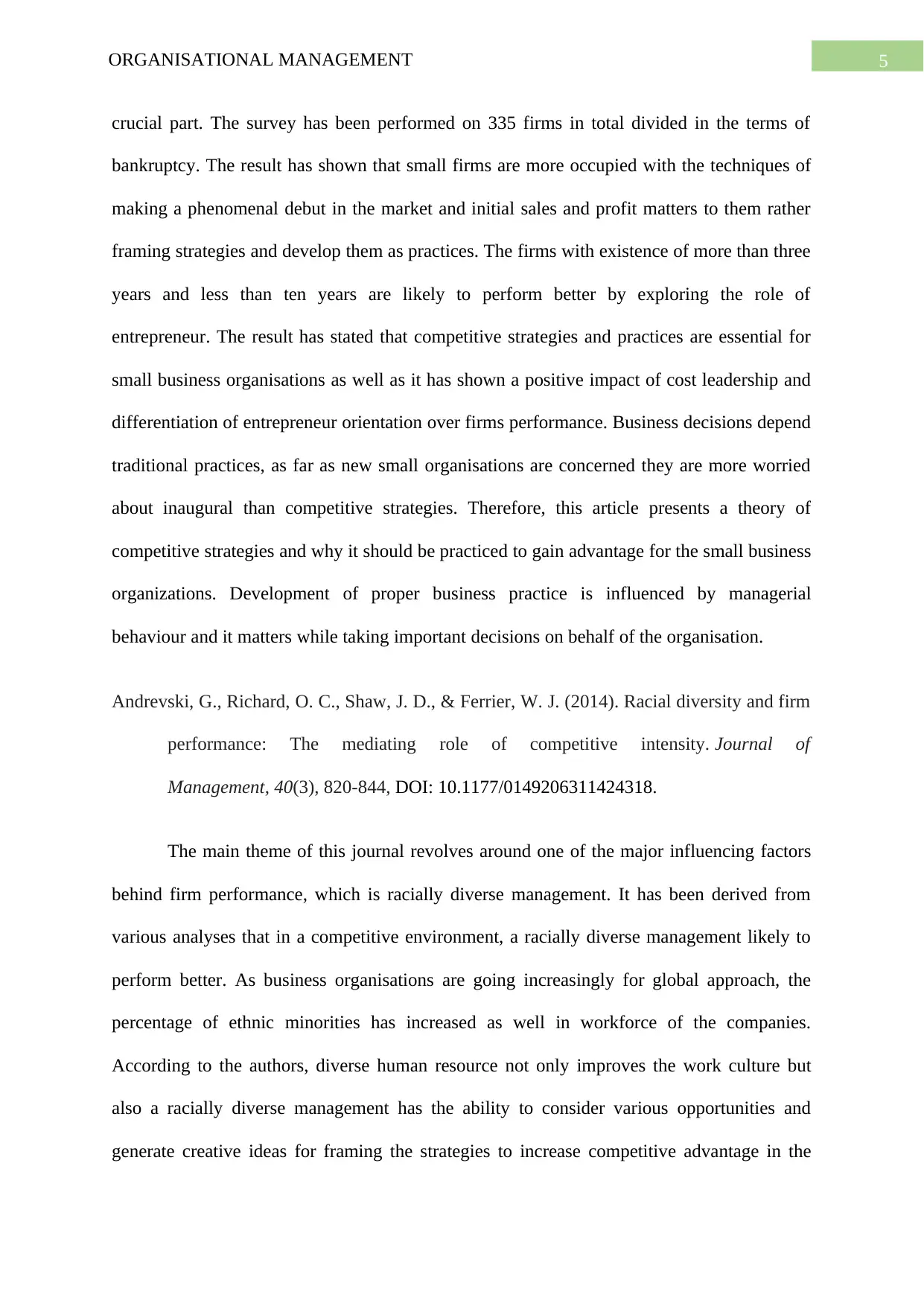
5ORGANISATIONAL MANAGEMENT
crucial part. The survey has been performed on 335 firms in total divided in the terms of
bankruptcy. The result has shown that small firms are more occupied with the techniques of
making a phenomenal debut in the market and initial sales and profit matters to them rather
framing strategies and develop them as practices. The firms with existence of more than three
years and less than ten years are likely to perform better by exploring the role of
entrepreneur. The result has stated that competitive strategies and practices are essential for
small business organisations as well as it has shown a positive impact of cost leadership and
differentiation of entrepreneur orientation over firms performance. Business decisions depend
traditional practices, as far as new small organisations are concerned they are more worried
about inaugural than competitive strategies. Therefore, this article presents a theory of
competitive strategies and why it should be practiced to gain advantage for the small business
organizations. Development of proper business practice is influenced by managerial
behaviour and it matters while taking important decisions on behalf of the organisation.
Andrevski, G., Richard, O. C., Shaw, J. D., & Ferrier, W. J. (2014). Racial diversity and firm
performance: The mediating role of competitive intensity. Journal of
Management, 40(3), 820-844, DOI: 10.1177/0149206311424318.
The main theme of this journal revolves around one of the major influencing factors
behind firm performance, which is racially diverse management. It has been derived from
various analyses that in a competitive environment, a racially diverse management likely to
perform better. As business organisations are going increasingly for global approach, the
percentage of ethnic minorities has increased as well in workforce of the companies.
According to the authors, diverse human resource not only improves the work culture but
also a racially diverse management has the ability to consider various opportunities and
generate creative ideas for framing the strategies to increase competitive advantage in the
crucial part. The survey has been performed on 335 firms in total divided in the terms of
bankruptcy. The result has shown that small firms are more occupied with the techniques of
making a phenomenal debut in the market and initial sales and profit matters to them rather
framing strategies and develop them as practices. The firms with existence of more than three
years and less than ten years are likely to perform better by exploring the role of
entrepreneur. The result has stated that competitive strategies and practices are essential for
small business organisations as well as it has shown a positive impact of cost leadership and
differentiation of entrepreneur orientation over firms performance. Business decisions depend
traditional practices, as far as new small organisations are concerned they are more worried
about inaugural than competitive strategies. Therefore, this article presents a theory of
competitive strategies and why it should be practiced to gain advantage for the small business
organizations. Development of proper business practice is influenced by managerial
behaviour and it matters while taking important decisions on behalf of the organisation.
Andrevski, G., Richard, O. C., Shaw, J. D., & Ferrier, W. J. (2014). Racial diversity and firm
performance: The mediating role of competitive intensity. Journal of
Management, 40(3), 820-844, DOI: 10.1177/0149206311424318.
The main theme of this journal revolves around one of the major influencing factors
behind firm performance, which is racially diverse management. It has been derived from
various analyses that in a competitive environment, a racially diverse management likely to
perform better. As business organisations are going increasingly for global approach, the
percentage of ethnic minorities has increased as well in workforce of the companies.
According to the authors, diverse human resource not only improves the work culture but
also a racially diverse management has the ability to consider various opportunities and
generate creative ideas for framing the strategies to increase competitive advantage in the
⊘ This is a preview!⊘
Do you want full access?
Subscribe today to unlock all pages.

Trusted by 1+ million students worldwide
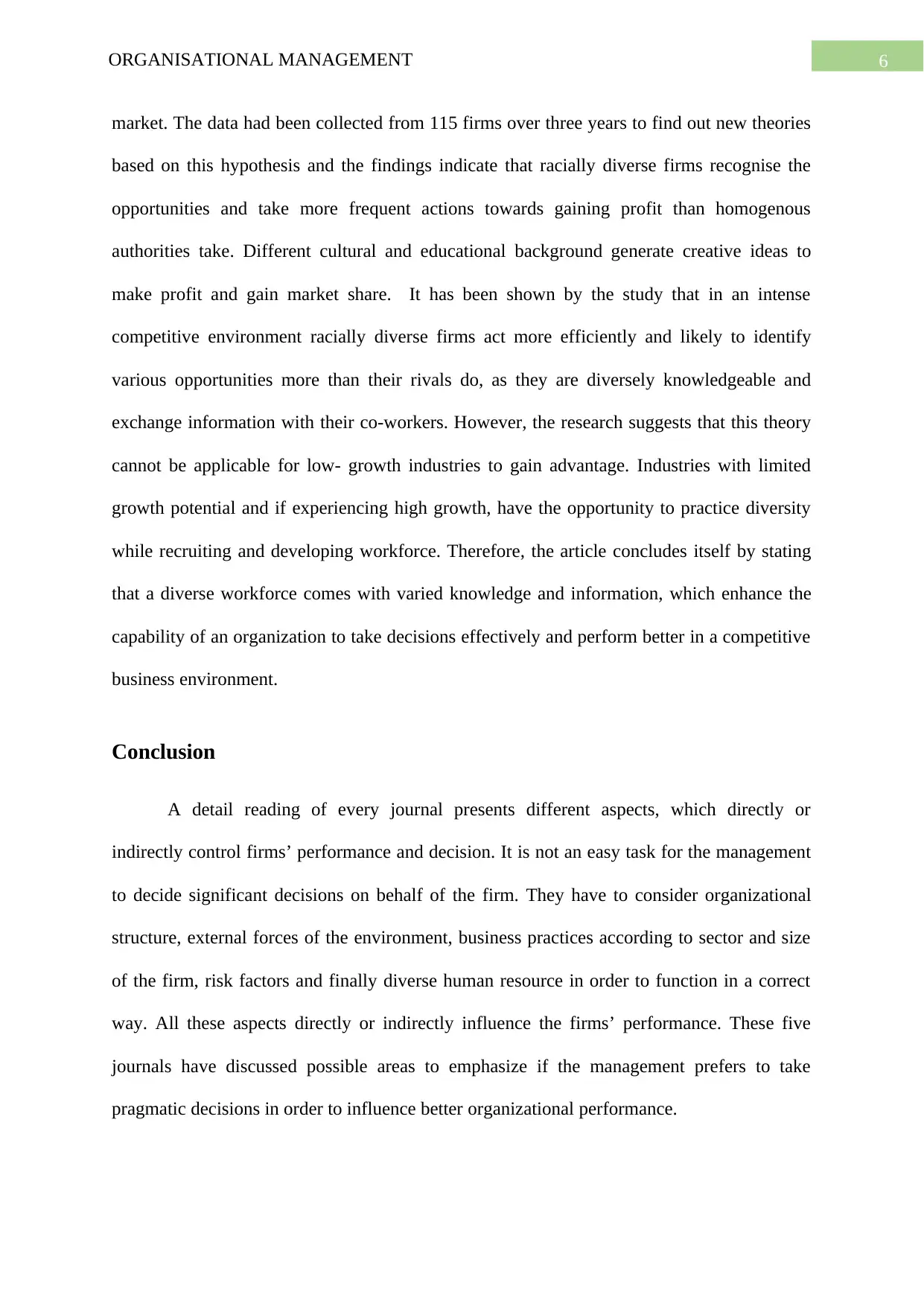
6ORGANISATIONAL MANAGEMENT
market. The data had been collected from 115 firms over three years to find out new theories
based on this hypothesis and the findings indicate that racially diverse firms recognise the
opportunities and take more frequent actions towards gaining profit than homogenous
authorities take. Different cultural and educational background generate creative ideas to
make profit and gain market share. It has been shown by the study that in an intense
competitive environment racially diverse firms act more efficiently and likely to identify
various opportunities more than their rivals do, as they are diversely knowledgeable and
exchange information with their co-workers. However, the research suggests that this theory
cannot be applicable for low- growth industries to gain advantage. Industries with limited
growth potential and if experiencing high growth, have the opportunity to practice diversity
while recruiting and developing workforce. Therefore, the article concludes itself by stating
that a diverse workforce comes with varied knowledge and information, which enhance the
capability of an organization to take decisions effectively and perform better in a competitive
business environment.
Conclusion
A detail reading of every journal presents different aspects, which directly or
indirectly control firms’ performance and decision. It is not an easy task for the management
to decide significant decisions on behalf of the firm. They have to consider organizational
structure, external forces of the environment, business practices according to sector and size
of the firm, risk factors and finally diverse human resource in order to function in a correct
way. All these aspects directly or indirectly influence the firms’ performance. These five
journals have discussed possible areas to emphasize if the management prefers to take
pragmatic decisions in order to influence better organizational performance.
market. The data had been collected from 115 firms over three years to find out new theories
based on this hypothesis and the findings indicate that racially diverse firms recognise the
opportunities and take more frequent actions towards gaining profit than homogenous
authorities take. Different cultural and educational background generate creative ideas to
make profit and gain market share. It has been shown by the study that in an intense
competitive environment racially diverse firms act more efficiently and likely to identify
various opportunities more than their rivals do, as they are diversely knowledgeable and
exchange information with their co-workers. However, the research suggests that this theory
cannot be applicable for low- growth industries to gain advantage. Industries with limited
growth potential and if experiencing high growth, have the opportunity to practice diversity
while recruiting and developing workforce. Therefore, the article concludes itself by stating
that a diverse workforce comes with varied knowledge and information, which enhance the
capability of an organization to take decisions effectively and perform better in a competitive
business environment.
Conclusion
A detail reading of every journal presents different aspects, which directly or
indirectly control firms’ performance and decision. It is not an easy task for the management
to decide significant decisions on behalf of the firm. They have to consider organizational
structure, external forces of the environment, business practices according to sector and size
of the firm, risk factors and finally diverse human resource in order to function in a correct
way. All these aspects directly or indirectly influence the firms’ performance. These five
journals have discussed possible areas to emphasize if the management prefers to take
pragmatic decisions in order to influence better organizational performance.
Paraphrase This Document
Need a fresh take? Get an instant paraphrase of this document with our AI Paraphraser
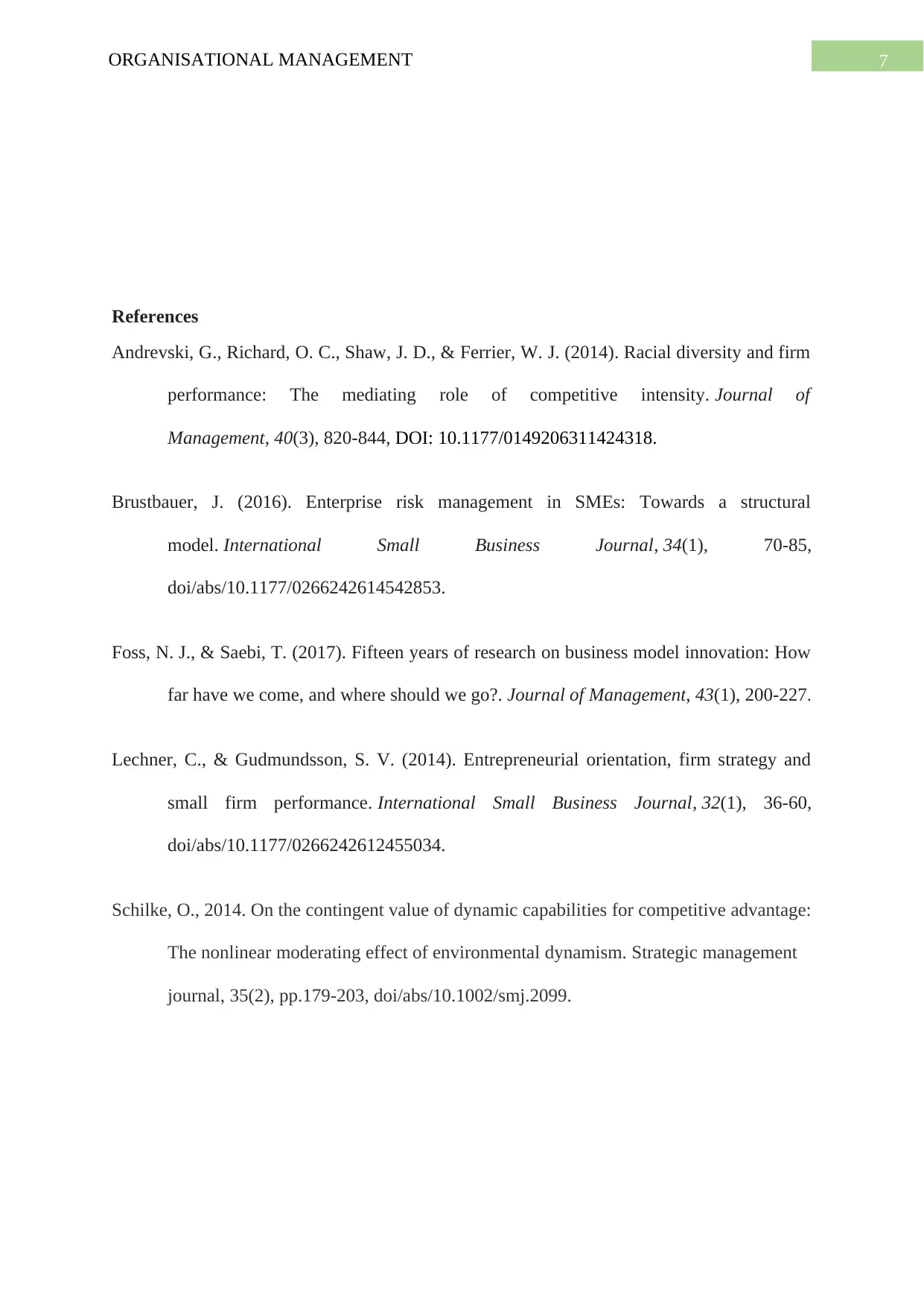
7ORGANISATIONAL MANAGEMENT
References
Andrevski, G., Richard, O. C., Shaw, J. D., & Ferrier, W. J. (2014). Racial diversity and firm
performance: The mediating role of competitive intensity. Journal of
Management, 40(3), 820-844, DOI: 10.1177/0149206311424318.
Brustbauer, J. (2016). Enterprise risk management in SMEs: Towards a structural
model. International Small Business Journal, 34(1), 70-85,
doi/abs/10.1177/0266242614542853.
Foss, N. J., & Saebi, T. (2017). Fifteen years of research on business model innovation: How
far have we come, and where should we go?. Journal of Management, 43(1), 200-227.
Lechner, C., & Gudmundsson, S. V. (2014). Entrepreneurial orientation, firm strategy and
small firm performance. International Small Business Journal, 32(1), 36-60,
doi/abs/10.1177/0266242612455034.
Schilke, O., 2014. On the contingent value of dynamic capabilities for competitive advantage:
The nonlinear moderating effect of environmental dynamism. Strategic management
journal, 35(2), pp.179-203, doi/abs/10.1002/smj.2099.
References
Andrevski, G., Richard, O. C., Shaw, J. D., & Ferrier, W. J. (2014). Racial diversity and firm
performance: The mediating role of competitive intensity. Journal of
Management, 40(3), 820-844, DOI: 10.1177/0149206311424318.
Brustbauer, J. (2016). Enterprise risk management in SMEs: Towards a structural
model. International Small Business Journal, 34(1), 70-85,
doi/abs/10.1177/0266242614542853.
Foss, N. J., & Saebi, T. (2017). Fifteen years of research on business model innovation: How
far have we come, and where should we go?. Journal of Management, 43(1), 200-227.
Lechner, C., & Gudmundsson, S. V. (2014). Entrepreneurial orientation, firm strategy and
small firm performance. International Small Business Journal, 32(1), 36-60,
doi/abs/10.1177/0266242612455034.
Schilke, O., 2014. On the contingent value of dynamic capabilities for competitive advantage:
The nonlinear moderating effect of environmental dynamism. Strategic management
journal, 35(2), pp.179-203, doi/abs/10.1002/smj.2099.
1 out of 8
Related Documents
Your All-in-One AI-Powered Toolkit for Academic Success.
+13062052269
info@desklib.com
Available 24*7 on WhatsApp / Email
![[object Object]](/_next/static/media/star-bottom.7253800d.svg)
Unlock your academic potential
Copyright © 2020–2025 A2Z Services. All Rights Reserved. Developed and managed by ZUCOL.

